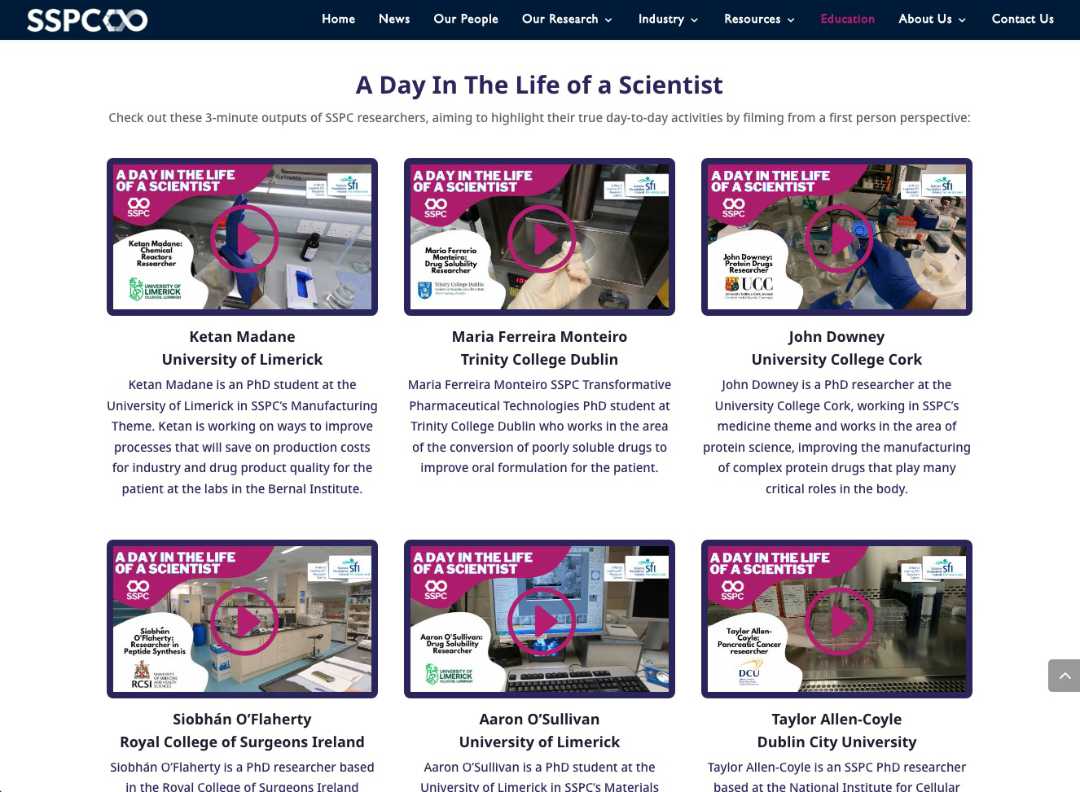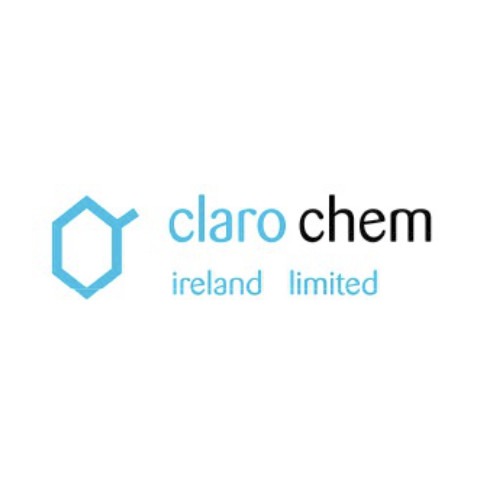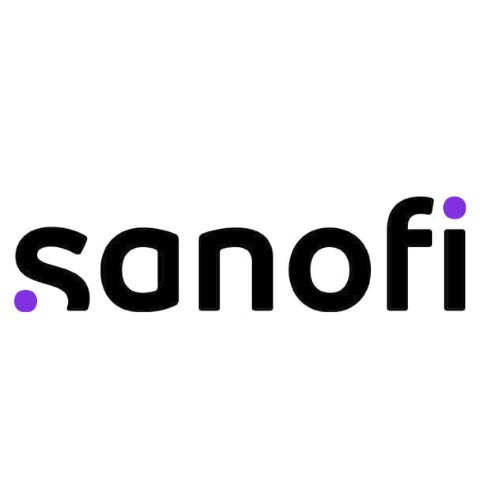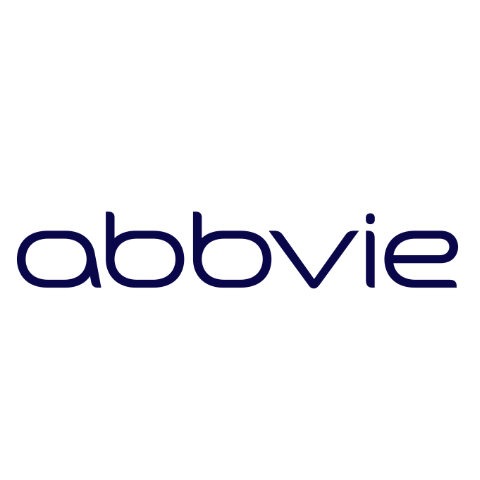The Campaign
The ‘A Day in Life of a Scientist’ Campaign uses point of view (POV) video to give an insight into the everyday lives of SSPC scientists and researchers. Using GoPros, our scientists captured their daily lives from morning until night. The importance of the campaign is to give a visual representation of scientists and the diversity in their everyday lives and work, helping to break societal stereotypes of scientists.
The videos are highly accessible and social with a target audience on YouTube and other social media. They focus on the work-life balance of scientists, how our they collaborate with others and get to work in some of the most picturesque campuses and buildings around Ireland. In total the campaign consists of 6 videos co-created with our scientists.
https://www.youtube.com/watch?v=p_8C_xvFNRs
Innovation
The ‘A Day in the Life…’ style videos are popular on social media such as YouTube and TikTok, becoming even more mainstream with the use of a first-person perspective. The rugged GoPro cameras are the standard in the space and have a dedicated online community. They cameras are easy to use, have a wealth of accessories and can record in a variety of video/audio formats. In this way the cameras can be placed anywhere and film almost anything. Throughout the campaign, they were mounted to bikes, used inside of research experiments and even in the shower! The POV perspective allows viewers to figuratively step into a person’s shoes for a day. Until now viewers could experience the life of sports people, movie stars or popstars, but never a scientist.
We were ‘first to market’ in the space and certain hurdles had to be overcome. For example, we had responsibility to demonstrate a typical day of one of our scientists while maintaining authenticity and not feeding into stereotypes. As such, we needed the videos to show our scientist’s morning routine, hobbies, commute, diet and work interactions. To achieve this, the videos are divided into three segments, morning, work, and after work, split evenly. Within these criteria it was flexible to the input of our scientists, given that they would be filming their lives.
After examining successful videos on YouTube, we embraced their stylistic choices: editing style, structure, music, voiceover and more. As such the videos are intentionally shot in a fast-paced manner, with zero narration, with every sequence of film feeding into the next so that the story of the day is easy to follow.
To help plan this we hosted multiple online meetings with our scientists to facilitate co-creation and peer learning, teaching them about storyboarding and providing instructional materials including a campaign and participant guide (linked below). Filming was conducted in pairs and equipment was sent via registered post to the next group (interactions were limited to online due to the COVID-19 pandemic). Each pair took approximately 1 month to complete filming with footage being labelled through storyboards and uploaded into an online server for editing.
An innovative approach was also taken in our promotion. Aware that the videos are a non-traditional form of media and communications, we decided to target online viewers and communities who would identify most with the videos. As such we decided to use Reddit, an online bulletin board with around 430 million users, for promotion. The site allows posts of any content and can be filtered by groups called ‘subreddits’. As part of our promotional campaign, we posted the videos to multiple subreddits including r/LadiesofScience, r/ScienceTeachers and r/goprodiy. Multiple videos gained traction from the platform with users ‘upvoting’ and spreading the content.
While this phase of the campaign is over, we are now engaging with Twinkl, the largest educational publishing house in the European Union (EU) to create school resources such as quizzes and puzzles to accompany the videos. Thus allows the videos to be used in primary school classrooms across the EU, and to note that they do not require English as their first language.
Examples
Campaign Manual and Participant Guide – A Day in the Life of a Scientist.pdf
The videos can be viewed on YouTube using the links below:
Video 1 – Ketan Madane, University of Limerick
Video 2 – Maria Ferreira, Trinity College Dublin
Video 3 – John Downey, University College Cork
Video 4 – Siobhán O’Flaherty, Royal College of Surgeons
Video 5 – Aaron O’Sullivan, University of Limerick
Video 6 – Taylor Allen Coyle, Dublin City University
Outcomes & Results
took place before the filming was vital for success. We had to ensure that our participating scientists understood the objectives to achieve the type of video we were trying to create. From the statistics below, we feel we have achieved our objectives.
In terms of views and engagements, the suite of videos has
- 14,056 views on YouTube
- An average view time of 68 seconds
- A watch time of 178 hours
A core part of this success was our first video going ‘viral’ comprising the majority of views and then being part of YouTube’s suggested links. Figure 2 below outlines the jump in views through online sharing. Figure 3 demonstrates how 36% of this traffic came from Reddit (106 upvotes on Reddit), while more traditional platforms also contributed to dissemination.
A key part of the dissemination of the videos is that they can be viewed by non-native speakers. This played a pivotal factor in our outcomes, geographically, Ireland is the only EU country that placed in the top ten of our viewership with countries such as Brazil, Vietnam and Mexico in our top 3.
In terms of other media and analytics, we have had over 1,000 visits to the sspc.ie website to view the short videos. On Twitter the overall impressions stands at 16,916 and overall engagements at 600. SSPC utilised Instagram reels, which secured over 1,600 views on this platform. On LinkedIn, each video had over 100 views.
Finally, other indicators of success include our interactions with viewers and people who want to engage with the content. At present, SSPC has been invited to present the project at the Higher Education Authority (HEI) Communication Managers Network as an example project that could be followed by other types of scientists, not just pharma researchers. Finally the project has also been featured on the UL Engage website as part of a selection of projects designed to engage the local community with the university.

















